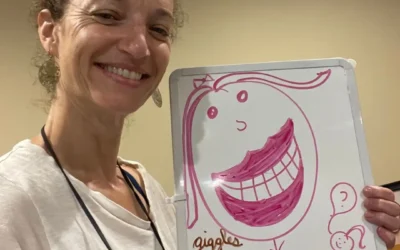My sister gave me a coaster that said, “In the cookies of life, sisters are the chocolate chips.” It got me thinking that for many students, teachers are the chocolate chips.
Children want to please their teachers, but let’s be honest…haven’t we all had a knotted stomach in anticipation of one kid who consistently disrupts an entire lesson?
As teachers, we signed up for this calling with a burning passion to help. We learned our craft meticulously. We spent hours creating lessons with enthusiasm and vigor. But, with the demand for academic progress skyrocketing, limited time, limited resources, and limited energy, the ripple effect from one disruptive student places us under enormous pressure.
Before cookie dough was pre-mixed into a plastic container, I had to get all the ingredients:
- flour,
- baking soda,
- baking powder,
- salt,
- eggs,
- vanilla,
- sugar, and
- chocolate chips.
I would happily lick my fingers and repeatedly dip them in the sugar…but it only took one dip into the flour to know I wouldn’t try that again!
That one disruptive kid who is struggling is like a cookie that might have, too much salt, or too much flour. It’s usually not their fault…some stress factor created the imbalance.
Because children don’t choose this. Children want to please their teachers.
In a classroom of 20 kids, 1 or 2 are dealing with serious stress linked to:
- poverty,
- domestic violence,
- abuse and neglect,
- trauma, or
- a psychiatric disorder in their home.
I don’t remember being prepared for this in teacher college.
Teachers are simply not trained on how to manage kids who are:
- struggling to regulate their emotions so they can focus
- lacking in basic skills to regulate their behaviors
- unable to recognize their own actions
- inflexible
- have outbursts for no apparent reason
- defy school personnel repeatedly
- argue constantly
And it’s not for lack of trying…but teachers need some new tools to change the behavior, not ‘manage’, but change it...long term.
What if we can move the needle by balancing the bitterness with some targeted tactics? It’s time to look at what’s really going on behind the curtains for these kids. We’re teachers – we all like a good puzzle to solve. Some CSI in the classroom can help us figure out what drives a student to misbehave. Then, we can apply a variety of strategies to intervene effectively before the behavior is rooted in the environment.
Misbehavior is a symptom of an under-developed skill, children blow-up or act out when they can’t cope with a situation.
If material is too hard, whether it is learning to
- tie their shoe,
- sound out a word, or
- write an essay
Misbehavior is coming from a place of inadequacy.
This is where we can do what we signed up to do – TEACH!
Misbehavior is a form of communication or actions they intentionally take to solve their problem. Usually, it is a response to something someone else did or said.
If Sally always gets up to use the bathroom when the teacher announces everyone will take turns reading aloud, we can conclude Sally does not feel comfortable reading aloud and may need extra support.
This is where we can do what we signed up to do – TEACH!
If a student is routinely disrespectful, and there are no consequences, the student has no reason to change his behavior.
This is where we can do what we signed up to do – TEACH!
Whether it is an academic or social situation, it causes them anxiety.
Three common denominators:
- The behavior has function; student gets attention, and student gets out of doing a task
- The behavior occurs in patterns; there is a trigger (i.e. reading aloud or getting shoes on to play outside)
- The behavior can be changed with targeted, explicit instruction.
This is where we can do what we signed up to do – TEACH!
Now, this is not a magic wand that always works immediately, but some behaviors addressed accurately can result in immediate changes. The behaviors that are deeply entrenched require extra work…because you might be the only one holding them accountable.
Every day, they return to their stress-ridden lives and sometimes every step forward is followed by three steps back.
That’s where FAIR comes in.
The goal is to change inappropriate behavior to appropriate behavior for the long-term.
FAIR
- Functional Hypothesis
- Accommodations
- Interaction Strategies
- Response Strategies
5 Steps to FAIR:
1. Understand triggers and minimize cause.
a. I had a student I met every morning before school. As much as I think I’m pretty fun to be around, I’m not sure I would want to see my teacher while still in my pajamas. I couldn’t change the meeting time, but I could change how we used the first 10 minutes.
b. I invited this child to enjoy her breakfast, while I read her a story that we were working on. This allowed her to eat her breakfast and have 10 minutes to wake up.
2. Avoid outbursts triggered by academic demands.
a. One incredibly capable student with very low self-esteem would see a word list and groan. The groan turned into his head on the table.
b. I suggested we do 5 words. I counted to the 5th word and the child could visually see the amount. There were days when 5 was too much. On these days, I asked, how many would you like to do? Sometimes it was 2 or 3 words, and then realized it was VERY manageable and would often continue.
c. But there were days when 2 or 3 were not possible. On these days, I read 5…and the child listened.
d. After several months, the child could do up to 5 pages!
e. This student needed:
i. Scaffolding
ii. understanding, and
iii. to know it’s safe to lean on your teacher.
3. A replacement behavior to fulfil the same need in a way that is positive.
a. One student consistently muted me or turned off the video during class. I decided to indulge this need for ‘technology distractions’. I showed up on zoom with different hats and emoji’s. This was very funny and we tried on different masks and faces and had a good laugh. More self-control followed, I let the child share things of interest with me on the internet. Eventually, the child would ask to show me things as soon as the lesson began. After the work was done, I did.
4. Teaching under-developed skills eventually eliminates replacement behavior.
a. By scaffolding and taking small, manageable steps, we actually replace the behavior as seen above.
5. When preventing the outburst is unavoidable.
a. It happens. Despite our good intentions, the stress factors can rear their ugliness and it can all implode. How we respond is critical.
b. Acknowledge it went off the rails,
c. Share a personal experience to show empathy and use as a teaching moment.
d. Do not excuse the behavior. Admit it and see how you and your student can move forward with grace – lots of grace.
e. One student would consistently say, ‘My bad’ after any kind of error. Finally, I said, “let’s replace that with, ‘My good’ and figure out how we can learn from it.”…and the child replaced the verbiage ! “My bad” was replaced with “My good.”
So, when you are managing those challenging kids who have too much:
- flour
- salt
- baking soda and the like,
Fight back FAIR with smart strategies.
As teachers, we may be the one chocolate chip on that disruptive kid’s journey.
Make sure you’re warm and sweet and fight FAIR.

Discover more articles like this | Explore educational games to support learners and homeschooling
Disclaimer The ideas in this article are based on Breaking the Behavior Code, by Nancy Rappaport and Jessica Minahan
www.childmind.org



